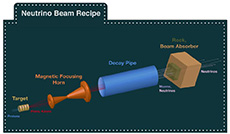How to make a neutrino beam
 |
| Ingredients for a neutrino beam: speedy protons, target, magnetic horn, decay pipe, absorbers. Image adapted from Fermilab
|
Fermilab is in the middle of expanding its neutrino program and is developing new detectors to study these ghostly particles. With its exquisite particle accelerator complex, Fermilab is capable of creating very intense beams of neutrinos.
Our neutrino recipe starts with a tank of hydrogen. The hydrogen atoms are fed an extra electron to make them negatively charged, allowing them to be accelerated. Once the charged atoms are accelerated, all of the electrons are ripped off, leaving a beam of positive protons. The protons are extracted into either the Booster Neutrino Beamline (BNB) or are further accelerated and extracted into the Neutrino Main Injector beamline (NuMI). Fermilab is the only laboratory with two neutrino beams. Our two beams have different energies, which allows us to study different properties of the neutrinos.
In the BNB, these protons smash into a target to break up the strong bonds of the quarks inside the proton. These collisions are so violent that they produce new quarks from their excess energy. These quarks immediately form together again into lighter composite short-lived particles called pions and kaons.
Since the pions and kaons emerge at different directions and speeds, they need to be herded together. As a bugle tunes your breath into musical notes, a horn of a different type rounds up and focuses the pions and kaons. The BNB horn looks roughly like the bell of a six-foot long bugle. It produces an electric field that in turn generates a funnel-like magnetic field, which directs all of the dispersed pions and kaons of positive electric charge straight ahead. Particles with negative charges get defocused. By switching the direction of the electric field, we can focus the negatively charged particles while defocusing the positive charges.
The focused particles in the BNB beam travel through a 50-meter long tunnel. This is where the magic happens. In this empty tunnel, the pions and kaons decay in flight into neutrinos, electrons and muons. At the end of the decay tunnel is a wall of steel and concrete to stop and absorb any particle that is not a neutrino. Because neutrinos interact so rarely, they easily whiz through the absorbers and on towards the experiments. And that’s the basic formula to make a beam of neutrinos!
A single neutrino beamline can support many experiments because the neutrinos interact too rarely to get “used up.” The BNB feeds neutrinos to MicroBooNE, and most of them go on through to the other side towards the MiniBooNE detector. Similarly, most of those go on through the other side as well and continue traveling to infinity and beyond. Detectors located in this beam measure neutrino oscillations and their interactions.
The NuMI beamline is designed similarly, but uses a different target material, two focusing horns, and a 675-meter decay pipe. The spacing between the two NuMI horns is adjustable, allowing fine-tuning of the neutrino beam energy. The NuMI beamline has higher-energy neutrinos than the BNB and thus studies different properties of neutrino oscillations.
The NuMI beamline feeds neutrinos to the MINERvA experiment and on through to the MINOS near detector. The NuMI beamline then continues about 450 miles through Earth on toward the MINOS far detector in the Soudan mine in Minnesota. By the time the beam reaches the far detector, it is about 20 miles in diameter! By having a near and far detector, we are able to observe neutrino flavor oscillations by measuring how much of the beam is electron neutrino flavor and muon neutrino flavor at each of these two detectors.
The last of the big Fermilab neutrino experiments is NOvA. Its near detector is off to the side of the NuMI beam and measures neutrinos only with a specific range of direction and energy. The NOvA far detector is positioned to measure the neutrinos with the same properties at a greater distance, about 500 miles away in Ash River, Minnesota. By placing the NOvA detectors 3 degrees to the side of the beam’s center, NOvA will get to make more precise oscillation measurements for a range of neutrino energies.
As more experiments are designed with more demanding requirements, Fermilab may expect to see more neutrino beamline R&D and the construction of new beamlines.
—Tia Miceli
Want a phrase defined? Have a question? Email today@fnal.gov.
|